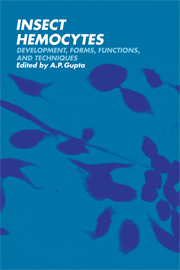Book contents
- Frontmatter
- Contents
- Preface
- List of contributors
- Part I Development and differentiation
- Part II Forms and structure
- Part III Functions
- 11 Hemocytes and growth in insects
- 12 Hemocytes and connective tissue: a critical assessment
- 13 Role of hemocytes in defense against biological agents
- 14 Cellular and humoral responses to toxic substances
- 15 Biochemical and ultrastructural aspects of synthesis, storage, and secretion in hemocytes
- 16 Changes in hemocyte populations
- Part IV Techniques
- Indexes
15 - Biochemical and ultrastructural aspects of synthesis, storage, and secretion in hemocytes
Published online by Cambridge University Press: 04 August 2010
- Frontmatter
- Contents
- Preface
- List of contributors
- Part I Development and differentiation
- Part II Forms and structure
- Part III Functions
- 11 Hemocytes and growth in insects
- 12 Hemocytes and connective tissue: a critical assessment
- 13 Role of hemocytes in defense against biological agents
- 14 Cellular and humoral responses to toxic substances
- 15 Biochemical and ultrastructural aspects of synthesis, storage, and secretion in hemocytes
- 16 Changes in hemocyte populations
- Part IV Techniques
- Indexes
Summary
Introduction
Mesodermal stem cells (i.e., cells migrating inward at the gastral groove during gastrulation of the embryo) differentiate into a host of specialized tissues including hemocytes (Anderson, 1972a,b) (see also Chapter 1). Specialization is recognized by particular synthetic abilities, and ultimately differentiation might be regarded as derepression of certain genes leading to synthesis of particular proteins. A particular gene may be derepressed briefly or more permanently, when we come to be able to recognize the cell as differentiated using biochemical or ultrastructural criteria. The wide variety of possible protein syntheses makes it difficult not only to classify differentiated hemocytes, but also to distinguish hemocytes from other mesodermal cells, for if hemocytes are considered simply as a mobilization or muster of mesodermal cells, then this muster at times includes transient migrations of mesodermal cells such as myoblasts (Crossley, 1965, 1972a). Conversely, if circulation is made an exclusive parameter, then hemocytes in hemocytopoietic organs and in hemocytic reservoirs (Jones, 1970) are excluded artificially. The importance of sessile hemocytic reservoirs, noted by Wigglesworth (1965), is emphasized by comparison of hemocyte counts before and after heat treatment, which prevents clumping and attachment of hemocytes (Wheeler, 1963).
The activities and hence appearance of sessile hemocytes may not differ greatly from those of connective tissue cells such as fibroblasts. Indeed, the embryological origin of fibroblasts is not clear, and they may, like hemocytes, arise from median mesoderm. Their relation to hemocytes is considered below, under “Hemocytes, Fibroblasts, and Collagen Secretion.” Cells believed to arise from lateral mesodermal somites are excluded from this review; this excludes myoblasts, cardioblasts, fat body cells, and pericardial cells.
- Type
- Chapter
- Information
- Insect HemocytesDevelopment, Forms, Functions and Techniques, pp. 423 - 474Publisher: Cambridge University PressPrint publication year: 1979
- 6
- Cited by



